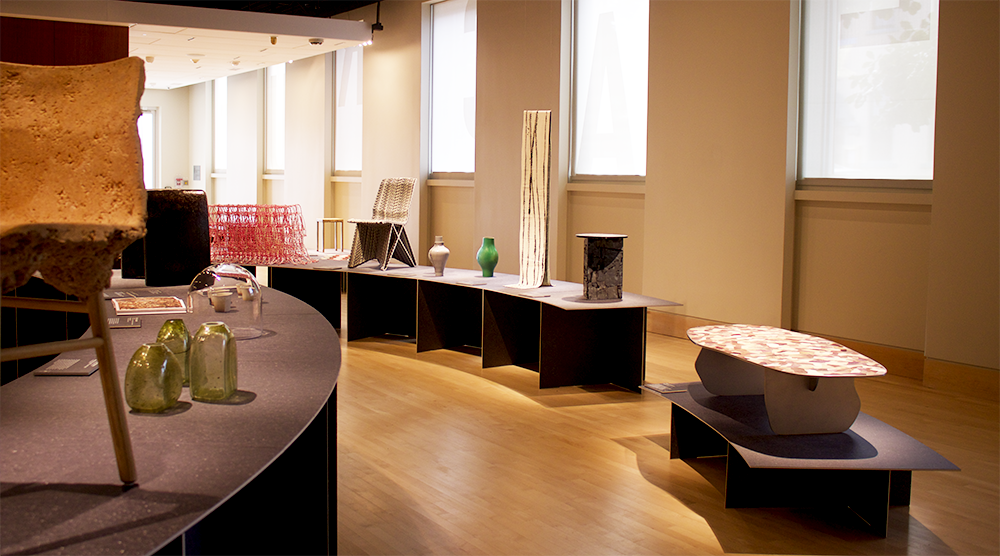Unconventional furniture and sleek versions of mundane household objects fill the Maria and Alberto de la Cruz Art Gallery. Walking around the new exhibit in the Edmund A. Walsh Building, one feels as though they catch a glimpse of the future. Although the exhibit is small, it contains powerful pieces that highlight the ability of a variety of waste materials to transform into artwork and functional items.
The exhibit, titled “Design Transfigured/Waste Reimagined,” showcased art created by many different artists spanning the globe, each of whom made their pieces from a variety of unconventional materials. Some of the innovative pieces serve as furniture, clothing and other utilitarian items, while others are abstract sculptures. This exhibit opened Oct. 3 and will run until Dec. 15.
At the exhibit’s opening reception on the evening of Oct. 2, people circulated throughout the room, observing the art and conversing about the materials’ implications within their own lives. Outside of the exhibit, there was an enjoyable and interactive craft section where visitors could use recycled projector slides to build objects and play with yarn made from recycled plastic bags. This activity gave participants the chance to link the subject matter of the pieces in the exhibit to their own creativity.
The artwork within the exhibit showcases a diverse range of materials and industries, successfully representing an accurate picture of the myriad waste products that go unused and unrecognized in contemporary society.

The pieces included works from artists like Sinae Kim, whose collection of “Urine Ware,” featured a ceramic bowl in the shape of a bladder covered in a glaze made of urine, and Oksana Bondar’s “Wiggy,” a stool formed from hair, seem peculiar or even revolting at first glance. Despite their relative oddness, these designs use human waste in a novel way while challenging viewers to consider all the possible ways in which used materials in their lives could be repurposed. Most of the items showcased are minimalist in their design and medium while being both aesthetically appealing and concordant with current trends in interior design.
The distinctive textures of many of the objects capture the viewer’s attention; it is tempting to touch them. From the smooth top of Sophie Rowley’s marbled collection “Bahia Denim,” a table made of jean remnants, to the sharp, crystalline structure of Charlotte Kidger’s “Material Futures,” composed of sawdust, tactile imagery engages the senses throughout the exhibit.
“Design Transfigured/Waste Reimagined” excels at showcasing the thoughtful and complex artistic processes that were used to create the objects on display. Within the exhibit, a technology station is set up where visitors can use headphones to learn more about the artists and processes behind the works, adding more context to their design.
In the case of Christien Meindertsma, whose “Really” industrial textile is used in the exhibit’s components, the artist’s book is included, showing details about the process of her design. The inclusion of this book emphasizes the careful design, planning and creation that has gone into every piece on display.
Furthermore, each artwork featured in the exhibit comments on an important social or environmental issue. By incorporating fashion items, such as shoes, a backpack and a shirt, the exhibit addresses the topical discussion of ethical consumerism in fashion.
In a time when “fast fashion” companies such as Forever 21 struggle to survive as consumers turn to more ecologically responsible options like thrifting, the concept of creating clothing from used materials is promising.
Perhaps some of the furniture in the exhibit is more aesthetically appealing than it is pragmatic for use in the typical American household, but its inclusion makes an important statement about the need for an increased focus on sustainability within the furniture industry.
“Design Transfigured/Waste Reimagined” provides a platform where sculpture and construction can redefine the concept of beauty. There is an indefinable quality stemming from the age of the pieces within this exhibit; the materials’ histories and past uses give them a story that shines through the art.
The collection is diverse and inclusive — the artists come from a wide range of geographical locations and backgrounds, and the repurposed items represent a variety of different industries, including agriculture, fossil fuel production, lumber and plastics. By combining all of these different settings with art, the exhibit develops original images of solutions to waste that stretch across disciplines and build off of each other.
This exhibit was a refreshing break from consumer culture and serves as a look at art as something both functional and aesthetically pleasing. It illuminates novel ways in which materials can be reused in an artistic setting, and inspires further discussion. “Design Transfigured/Waste Reimagined” helps to imagine a more ethical future for manufacturing and waste, while outlining some of the steps that can be taken to achieve this ideal



















